

5 Ways to Engage Students. The eyes roll back, the mouth scowls, the fingers grip the not-so-secretly hidden cellphone, and the brain checks out.
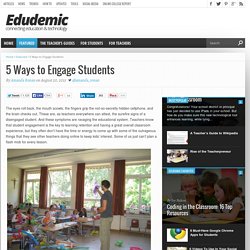
These are, as teachers everywhere can attest, the surefire signs of a disengaged student. And these symptoms are ravaging the educational system. Teachers know that student engagement is the key to learning retention and having a great overall classroom experience, but they often don’t have the time or energy to come up with some of the outrageous things that they see other teachers doing online to keep kids’ interest. Some of us just can’t plan a flash mob for every lesson. Disengaged students are unmotivated to complete their work, apathetic about learning outcomes, and resistant to participating in classwork. 6 Surprising Insights Of Successful Employee Engagement. Finally, leaders are now convinced one of their last remaining competitive advantages lies with their people.

Businesses have begun to signal to workers that their needs will now be honored on a scale only previously reserved for customers and shareholders. Raising employee engagement has become one of the highest priorities for organizations all around the globe, according to a 2015 Conference Board CEO study. While leaders have come to appreciate the importance of having a fully engaged workforce, they also have a very limited understanding of what practices truly drive and sustain it. Researchers from Deloitte Consulting, Sirota, and the Conference Board combined efforts in October 2014, and performed a deep dive into 12 companies consistently recognized for having high-performing, employee-centric cultures.
How to Keep Kids Engaged in Class. Have you ever plunked yourself down in a staff meeting where some of your colleagues were, for lack of a better phrase, not paying attention?
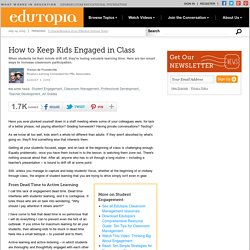
Grading homework? Having private conversations? Texting? As we know all too well, kids aren't a whole lot different than adults: If they aren't absorbed by what's going on, they'll find something else that interests them. Golden Rules for Engaging Students in Learning Activities. When we think of student engagement in learning activities, it is often convenient to understand engagement with an activity as being represented by good behavior (i.e. behavioral engagement), positive feelings (i.e. emotional engagement), and, above all, student thinking (i.e. cognitive engagement) (Fredricks, 2014).

This is because students may be behaviorally and/or emotionally invested in a given activity without actually exerting the necessary mental effort to understand and master the knowledge, craft, or skill that the activity promotes. In light of this, research suggests that considering the following interrelated elements when designing and implementing learning activities may help increase student engagement behaviorally, emotionally, and cognitively, thereby positively affecting student learning and achievement. 1. Make It Meaningful In aiming for full engagement, it is essential that students perceive activities as being meaningful.
Center for Teaching and Learning. Research has demonstrated that engaging students in the learning process increases their attention and focus, motivates them to practice higher-level critical thinking skills and promotes meaningful learning experiences.
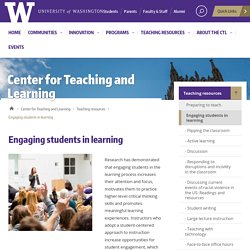
Instructors who adopt a student-centered approach to instruction increase opportunities for student engagement, which then helps everyone more successfully achieve the course’s learning objectives. Flipping the classroom A pedagogy-first approach to teaching in which in-class time is re-purposed for inquiry, application and assessment in order to better meet the needs of the individual learners. Read more. 5 Proven Ways to Engage Students In Your Classroom. How I’ll Engage My Students as Learners: Six Ways to Make Connections. As the beginning of the school year gets underway I ask myself this question: What learning environment will I provide so that my students can’t wait ’til the next class?
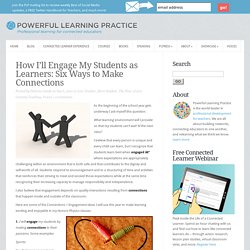
I believe that every person is unique and every child can learn, but I recognize that students learn best when engaged — where expectations are appropriately challenging within an environment that is both safe and that contributes to the dignity and self-worth of all. Students respond to encouragement and to a structuring of time and activities that reinforces their striving to meet and exceed those expectations while at the same time recognizing their increasing capacity to manage responsibility and independence. Educational Leadership:Teaching for Understanding:How To Engage Students in Learning.
To help teachers formulate their own definitions of understanding, I typically ask them about their deepest interest or intellectual passion, something they feel particularly articulate about, are in control of, and are good at.
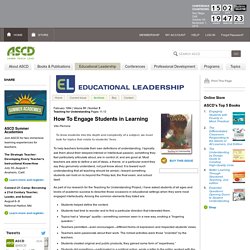
Most teachers are able to define a set of ideas, a theme, or a particular event they say they genuinely understand, not just know about. It is toward such understanding that all teaching should be aimed—toward something students can hold on to beyond the Friday test, the final exam, and school itself. Actively Engage Students Using Hands-on & Minds-on Instruction. Contrary to popular belief, “active engagement” involves more than “hands-on” instruction.

Years ago, I discovered this when I realized that hands-on teaching didn’t always result in student learning. Yes, my students had fun, but follow-up activities showed little grasp of essential concepts. How could that be? My students appeared to be actively engaged, but apparently only their hands and their mouths were active! My “ah-ah” moment came when I realized that both minds and hands are necessary for active engagement. Best Teaching Practices to Engage Your Students. Engage Your Students With These Open Educational Resources. R U Engaging Your Students? Strategies and Tools for the Texting Generation. Students and Smart Phones Go Together Like Reading and Writing.

Let’s Put Them to Use in the Service of Learning! In the U.S., and increasingly abroad, students of high school and college age require a smart phone as a standard part of their lifestyles. 8 Things to Look For in Today’s Classroom. As I think that leaders should be able to describe what they are looking for in schools I have thought of eight things that I really want to see in today’s classroom.

I really believe that classrooms need to be learner focused. This is not simply that students are creating but that they are also having opportunities to follow their interests and explore passions.1 The teacher should embody learning as well. Will Richardson recently wrote this in a comment on one of my recent posts on what teachers need to be like in our current day and the focus that needs to be on learning: …we need teachers who are masters at developing kids as learners who are adept at sense making around their own goals. An Acronym Leading to Empowerment in Schools (CEE) There are so many acronyms in education, that it could become a little overwhelming.
Not only because they are so many that educators could remember, but because they are often targeted to a specific area, not education as a whole. Although acronyms are meant to be simple to remember, they can often lead us to focusing on something other than deep learning. For example, many educators love promoting the use of the SAMR Model (Substitution Augmentation Modification Redefinition) for technology use in the classroom. The idea behind it is solid; what are you doing with the technology that you couldn’t do before?
Should We Be Engaging OR Empowering Learners? One of the themes that I’ve spent the past few days wrestling with is the difference between engaging and empowering our students. It’s a theme that Scott Glass and David Jakes touched on early in their Saturday Morning #educon session and it’s caught legs in Twitter — starting more conversations than pretty much every strand dropped in the stream over the weekend. Here’s my initial thinking, expressed in note form: (click to view/download #agencymatters on Flickr here) (click to view/download Engaging or Empowering on Flickr here) So what do YOU think? Light Bulbs and Laughter.